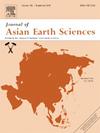Diagenetic and mineralogical impacts on clastic reservoir; A case study from the lower Indus Basin, Pakistan
IF 2.7
3区 地球科学
Q2 GEOSCIENCES, MULTIDISCIPLINARY
引用次数: 0
Abstract
The Pab Sandstone, a significant and heterogeneous hydrocarbon development target in Pakistan’s Lower Indus Basin, offers a unique opportunity to investigate diagenetic and depositional controls on reservoir quality. A substantial uncertainty in reservoir quality assessment pertains to diagenetic effects. An integrated approach, including detailed petrographic analysis, scanning electron microscopy, X-ray diffraction, helium porosity, and permeability measurements, was used to analyze the impact of identified diagenetic elements on reservoir quality. Visual core investigations show deposition within a semi-arid, highly sand-prone coastal–alluvial braided plain under the periodic weak marine influence. The presence of trough-shaped crossbedding, large bedform structures, bioturbation, and some fossils in selective horizons indicate near-shore channel environments. The channel sandstones range from very fine to very coarse-grained quartz arenites. Analysis of some core samples shows an abundance of quartz arenites and kaolinite as the major authigenic clay minerals. Core-derived porosity and permeability were found to be 6.34 % and 69.90 mD, respectively. Main diagenetic processes include compaction, quartz overgrowth, calcite cementation, and authigenic kaolinite. Reservoir properties are strongly facies-dependent and are related to depositional texture, detrital mineralogy, together with their diagenetic overprint. Sandstones are typically very clean, with secondary porosity, which is associated with partial leaching of mudclasts, feldspars, and dissolution of volcanic rock fragments. Permeability exhibits a positive correlation with increasing grain size in the quartzose sandstones. Porosity decreases with poorer sorting. The research findings can be utilized to understand the complications of sandstone reservoirs and develop better exploration strategies minimizing the economic losses associated with non-productive wells.

成岩和矿物学对碎屑岩储层的影响以巴基斯坦印度河下游为例
Pab砂岩是巴基斯坦下印度河盆地重要的非均质油气开发目标,为研究成岩和沉积对储层质量的控制提供了独特的机会。储层质量评价中的一个重大不确定性与成岩作用有关。通过详细的岩石学分析、扫描电子显微镜、x射线衍射、氦孔隙度和渗透率测量等综合方法,分析了已识别的成岩元素对储层质量的影响。目视岩心调查显示,在周期性的弱海洋影响下,沉积在半干旱、高度易产沙的海岸冲积辫状平原内。槽状交错层理、大型层状构造、生物扰动和部分选择性层位的化石显示了近岸河道环境。河道砂岩的粒度从极细到极粗的石英砂质不等。对部分岩心样品的分析表明,石英砂质岩和高岭石是主要的自生粘土矿物。岩心孔隙度和渗透率分别为6.34%和69.90 mD。主要成岩作用有压实作用、石英过度生长作用、方解石胶结作用和自生高岭石作用。储层物性与沉积结构、碎屑矿物学及其成岩覆层有关,具有很强的相依赖性。砂岩通常非常干净,具有次生孔隙,这与泥屑、长石的部分浸出和火山岩碎片的溶解有关。石英砂岩的渗透率与颗粒尺寸的增大呈正相关。分选越差,孔隙度越低。研究成果可用于了解砂岩储层的复杂性,制定更好的勘探策略,最大限度地减少非生产井的经济损失。
本文章由计算机程序翻译,如有差异,请以英文原文为准。
求助全文
约1分钟内获得全文
求助全文
来源期刊

Journal of Asian Earth Sciences
地学-地球科学综合
CiteScore
5.90
自引率
10.00%
发文量
324
审稿时长
71 days
期刊介绍:
Journal of Asian Earth Sciences has an open access mirror journal Journal of Asian Earth Sciences: X, sharing the same aims and scope, editorial team, submission system and rigorous peer review.
The Journal of Asian Earth Sciences is an international interdisciplinary journal devoted to all aspects of research related to the solid Earth Sciences of Asia. The Journal publishes high quality, peer-reviewed scientific papers on the regional geology, tectonics, geochemistry and geophysics of Asia. It will be devoted primarily to research papers but short communications relating to new developments of broad interest, reviews and book reviews will also be included. Papers must have international appeal and should present work of more than local significance.
The scope includes deep processes of the Asian continent and its adjacent oceans; seismology and earthquakes; orogeny, magmatism, metamorphism and volcanism; growth, deformation and destruction of the Asian crust; crust-mantle interaction; evolution of life (early life, biostratigraphy, biogeography and mass-extinction); fluids, fluxes and reservoirs of mineral and energy resources; surface processes (weathering, erosion, transport and deposition of sediments) and resulting geomorphology; and the response of the Earth to global climate change as viewed within the Asian continent and surrounding oceans.
 求助内容:
求助内容: 应助结果提醒方式:
应助结果提醒方式:


